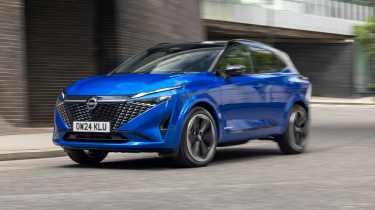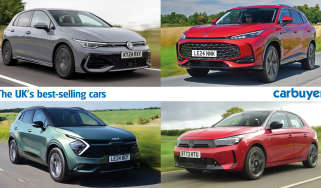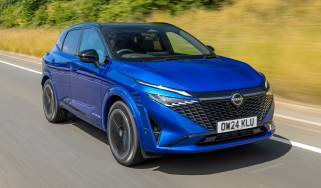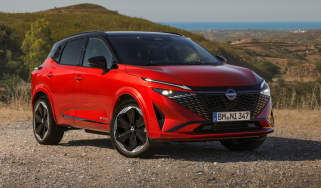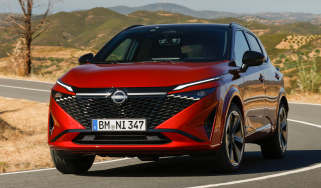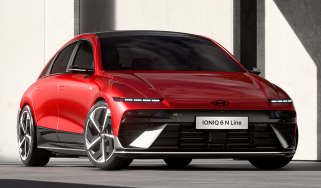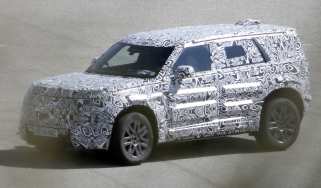Nissan Qashqai review - Engines, drive & performance
“The Nissan Qashqai is comfortable and smooth to drive, especially as an e-Power hybrid”
Family SUVs aren’t designed to be the best-handling cars on the road and the Qashqai’s popularity shows that handling is quite a way down the list of priorities for many buyers. The latest is good to drive and better than the old Qashqai it replaced in 2021, but keen drivers may still be happier in a Ford Kuga, MINI Countryman or Mazda CX-5.
Nissan has favoured smoothness and stability over driver involvement, which isn’t surprising. There’s little steering feel and the manual gearbox could be more precise, but refinement is good and the 1.3-litre petrol engine rarely gets noisy.
Most cars get a standard rear suspension setup and, for the majority of the time, the car rides well. It’s never uncomfortable and most buyers won’t care that it’s not quite the most poised car in its class. Higher spec in N-Design and Tekna+ trim get large 20-inch wheels and more advanced multi-link rear suspension but the two all but cancel each other out – providing a similarly composed ride without any real gain in the driving experience. We’d keep to the smaller wheels so that the car isn’t as fidgety – plus smaller wheels tend to make replacement tyres cheaper.
We like the e-Power hybrid the most to drive because it’s even more refined, rarely letting out a peep, and wind and road noise stays at a minimum even on the large wheels of our UK test car. It gets a more innovative setup than a conventional hybrid because the engine doesn’t actually drive the wheels, but instead charges a battery while an electric motor does the heavy lifting. As a result the e-Power drives much like an electric car with punchy acceleration from low speeds and no gear changes.
The e-Pedal setting allows you to lift off the throttle and the car automatically applies a regenerative braking force, but it’s not quite strong enough to enable one-pedal driving. The system recoups some of the energy lost to braking and puts it back into the battery, however, helping to improve efficiency, and there’s even a graphic on the dash to show you this as it happens. We don’t recommend using the e-Pedal mode on the motorway because it doesn’t always feel like the most responsive system when slowing down from higher speeds, which can be a little off-putting.
Is it good to drive in town?
Yes, the e-Power hybrid model especially is great for traffic jams as it runs on electric power smoothly and very quietly. Even the mild-hybrid is quiet unless revved hard. There’s an automatic gearbox for the normal petrol models that will be a good option for people who mainly drive in town.
Is it good to drive on long journeys?
The Qashqai is quiet inside and stays comfortable on the motorway, so we’d have no issue taking one on a long trip, but we were disappointed with the e-Pedal mode at the national speed limit, so we’d leave this feature off. The Qashqai’s Google-based infotainment will keep you abreast of traffic coming up, too. At cruising speeds, the Qashqai is nice and quiet inside with wind noise being the main intrusion.
Is it good to drive on B-roads?
While the Qashqai e-Power is quicker than you might expect, it certainly isn’t as good to drive as some of its rivals, including the Ford Kuga, on twisty roads. Body roll is kept to a minimum and it’s composed, but the steering lacks in feel – the Qashqai is aimed at those who don’t mind how a car handles, and just want something comfy and easy to drive.
Nissan Qashqai petrol engines
A 1.3-litre petrol engine is available with either 138bhp or 156bhp and features fuel-saving mild-hybrid tech. We drove a test car with the more powerful engine and performance was adequate, with 0-62mph taking 9.5 seconds. The 138bhp engine is unlikely to feel too much slower; you’ll still easily be able to get up to speed relatively quickly.
That means if you want a manual gearbox and two-wheel drive, you can save yourself a bit of money and stick with the 138bhp engine. The automatic gearbox and four-wheel drive are limited to the more powerful version, and four-wheel drive is only offered on N-Connecta, Tekna and Tekna+ trims.
|
Model |
Power |
0-62mph |
Top speed |
|
Qashqai 140 manual |
138bhp |
10.2s |
122mph |
|
Qashqai 158 manual |
156bhp |
9.5s |
128mph |
|
Qashqai 158 auto |
158bhp |
9.2s |
124mph |
Nissan Qashqai hybrid engine
The Qashqai e-Power offers a more impressive driving experience than the mild-hybrid petrol. Its acceleration is quicker and, more importantly, smoother, with no gear changes at lower speeds. The 1.5-litre petrol engine charges the battery or powers the electric motor, rather than powering the wheels directly, which helps it to have the characteristics of an electric car.
It’s far quieter than the mild-hybrid petrol engine, and you often can’t tell when the engine has kicked in at low speeds. When revved hard, however, the e-Power can sound a little rough and because power is applied so smoothly it doesn’t feel as fast as the 187bhp output might suggest. It lacks that instant surge of acceleration you get from a pure EV but this laid-back nature actually suits the Qashqai well. Nissan says that, in official emissions tests, it spent nearly two-thirds of the time on electric power without the petrol engine needing to work. That contributes to its improved fuel consumption figure.
Acceleration from 0-62mph takes 7.9 seconds, which is reasonably brisk for a family SUV, thanks to its output of 187bhp. It builds pace smoothly and can get up to motorway speeds without much fuss. Because the wheels are always powered with electricity, there’s none of the jerkiness of an automatic gearbox or some other hybrids which constantly shuffle power from different sources.
The engine revs more noticeably in stop-and-start traffic, but Nissan’s engineers have done a good job of keeping engine vibrations out of the cabin. At higher speeds, the engine has been programmed to match the speed of the car, so the revs don’t rise and fall in a jarring fashion.
Like an EV, the Qashqai also has an ‘I-Pedal’ feature, where the car feeds energy into the battery when you lift off the accelerator and the car slows to a crawling speed – however, it doesn’t come to a halt like the Nissan Leaf or Ariya. It’s easy to get used to though, and reinforces the e-Power as Nissan’s stepping-stone to EV ownership.
|
Model |
Power |
0-62mph |
Top speed |
|
Qashqai e-Power |
187bhp |
7.9s |
105mph |


